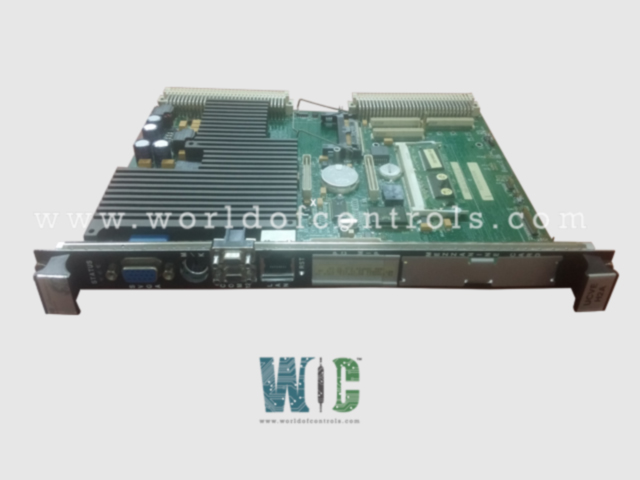
World Of Controls understands the criticality of your requirement and works towards reducing the lead time as much as possible.
IS215UCVEH2A - VME Controller Card is available in stock which ships the same day.
IS215UCVEH2A - VME Controller Card comes in UNUSED as well as REBUILT condition.
To avail our best deals for IS215UCVEH2A - VME Controller Card, contact us and we will get back to you within 24 hours.
SPECIFICATIONS:
Part No.: IS215UCVEH2A
Manufacturer: General Electric
Series: Mark VI
Product Type: Processor
Function: VME Controller Card
Operating System: QNX
Microprocessor: Intel Celeron 300 MHz
Memory: 32 MB DRAM
Primary Ethernet Interface (Ethernet 1): Twisted pair 10BaseT/100BaseTX, RJ-45 connector
COM Ports: COM1
Power Requirements: +5 V dc, 6 A typical, 8 A max
Programming: Boolean
Operating temperature: -30 to 65°C
Size: 8.26 cm high x 4.19 cm
Repair: 3-7 Day
Availability: In Stock
Weight: 2 lbs
Country of Origin: United States
Manual: GEH-6421M
FUNCTIONAL DESCRIPTION:
IS215UCVEH2A is a VME Controller Card manufactured and designed by General Electric as part of the Mark VI Series used in GE Speedtronic Control Systems. The UCVEH2 is the standard Mark VI controller. It is a single-slot board using a 300 MHz Intel Celeron processor with 16 or 128 MB of flash memory and 32 MB of DRAM. A single 10BaseT/100BaseTX (RJ-45) Ethernet port provides connectivity to the UDH. The UCVEM_ _ modules have all the features of the UCVEH2 with the addition of supporting additional Ethernet ports and Profibus. Some UCVEM_ _ modules support secondary 10BaseT/100BaseTX Ethernet ports for use on a separate IP logical subnet. The secondary Ethernet port is configured through the toolbox. The controller validates its toolbox configuration against the existing hardware each time the rack is powered up. A separate subnet address allows the controller to uniquely identify an Ethernet port.
COMPONENTS OF A VME CONTROLLER CARD:
Processor: The processor is the heart of the VME Controller Card, responsible for executing instructions and managing tasks. Modern VME cards often feature high-performance processors that can handle complex computations.
Memory: Memory on a VME Controller Card stores data temporarily for quick access by the processor. This includes both volatile memory (RAM) and non-volatile memory (ROM or flash storage).
Interface Ports: Interface ports allow the VME Controller Card to connect with other devices and modules. Common interfaces include Ethernet, USB, and serial ports, facilitating versatile connectivity options.
How VME Controller Cards Work:
Communication Protocols: VME Controller Cards use specific communication protocols to interact with other modules. These protocols ensure data integrity and efficient communication across the VMEbus.
Data Transfer Mechanisms: Data transfer within VME systems is typically managed through direct memory access (DMA), which allows high-speed data exchange without burdening the CPU.
ADVANTAGES OF USING VME CONTROLLER CARDS:
Reliability: VME Controller Cards are known for their robustness and long-term reliability, making them ideal for critical applications.
Scalability: VME systems can be easily expanded by adding more cards, allowing for scalable solutions that grow with technological advancements.
Longevity: Despite the fast-paced tech environment, VME Controller Cards have a long lifecycle, supported by consistent updates and community standards.
WOC has the largest stock of GE Speedtronic control systems OEM replacement parts. We can also repair your faulty boards and supply unused and rebuilt boards backed up with a warranty. Our team of experts is available round the clock to support your OEM needs. Our team of experts at WOC is happy to assist you with any of your automation requirements. For pricing and availability on parts and repairs, kindly contact our team by phone or email.
What are the key features of a VME Controller Card?
Some key features include high processing power, real-time capabilities, multiple I/O (input/output) channels for interfacing with sensors and actuators, and a rugged design suitable for harsh industrial environments.
How does the VME Controller Card communicate with other components in the control system?
Communication typically occurs through various protocols such as Ethernet, CAN (Controller Area Network), Modbus, or proprietary protocols, allowing the VME Controller Card to exchange data with supervisory systems, operator interfaces, and other control devices.
How do you ensure the security of the VME Controller Card and the control system?
Security measures may include encryption of communication channels, authentication protocols, physical access controls, and regular software updates to patch vulnerabilities.